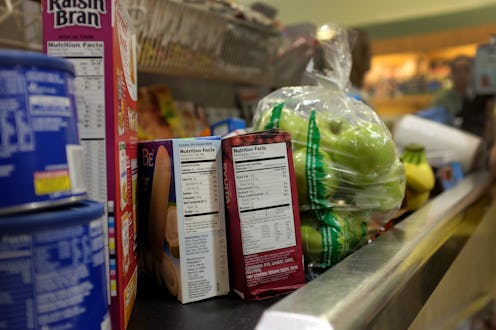Life
Quick Ways To Tell If A Food Is Nutritious
When it comes to health and nutrition, it can get confusing what's good for you and what you should skip. Looking at packaging doesn't help much either, and there are times when it would be great to have an list of easy ways to tell if a food is healthy. Of course, 'healthy' means different things to every person, and that's totally fine. But when it comes to focusing on vitamins and nutrients in food, knowing what makes a food truly nutritious is important. And when you have to decide what to eat in the moment, it can even help you figure out what foods to buy when you eat at home.
"It is difficult to have a quick way to tell if a food is healthy due to all the marketing ploys involved in packaging," says Beth Warren, MS, RDN, CDN over email. "Misleading terms such as 'natural,' 'organic,' 'sugar free,' 'fat free' and other labels leave out integral information about what is actually in the product, aside from the one ingredient or theme they choose to highlight. You have to read all the different ingredients and the nutrition facts label to make an educated decision on whether or not a product is healthy for you."
Most of us aren't nutrition experts, which can make interpreting a label confusing. However, focusing on the right components can help you focus on key components of a food's nutritional profile. Next time you're trying to figure out some quick ways to determine if your food is nutritious, pay attention to these 5 factors.
1. Read The Ingredient List
"Read the ingredient list, especially the first three," says Warren. "The sequence of ingredients is supposed to go in order of quantity. So, if sugar, enriched wheat flour, and other less healthful ingredients are listed first, the product consists of those ingredients the most."
2. Pay Attention To Types Of Fats
Looking at fat content is important, but you want to make sure you're focusing on the right kinds of fat. "We want to eliminate trans fat in the diet and lessen saturated fat, but boost our consumption of polyunsaturated and monounsaturated fats from products," says Warren. "A lot of times, consumers put down a product because its high in fat, but if its quality fat, it makes it a more healthful choice."
3. Look For "100 Percent"
"Check for 100 percent whole grains," says Warren. "Breads and other carbohydrate-filled products are one of the most confusing foods to buy. A lot of times it may say 'whole grain' or 'multigrain,' but it does not say '100 percent' before the term, meaning it's most likely processed with refined grains." Same goes for buying juices and other drinks as well. Look for the percentage of real fruit juice, because if it's not 100 percent, the rest is usually just sugar.
4. Focus On Fiber
Many people look at calories first on a nutrition facts label, but next time you're shopping, try not looking at it at all and focusing on other nutritious ingredients instead. "The calorie count is an overall picture, not a specific breakdown of what the calories are made up of," says Warren. "It is important to look at the quality nutrition of the product, and I find that seeing if a product has fiber helps eliminate a lot of simple-carbohydrate, high-sugar food products."
5. Check The Sugar Content
Americans consume over 100 grams of sugar daily, despite the American Heart Associations recommendations of 25 grams per day. Avoid foods high in sugar, and look at out for the sweetener's many hidden names.
When in doubt, opt for whole foods such as fruits, vegetables, and grains, which are bound to be free of unhealthy ingredients or additives.
Want more women's health coverage? Check out Bustle's new podcast, Honestly Though, which tackles all the questions you're afraid to ask.
Images: Getty Images (6)
